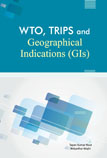Wto, Trips And Geographical Indications (gis)
By Tapan Kumar Rout , Bidyadhar Majhi(Author)
Intellectual property rights (IPRs) refer to the legal ownership by a person or business of an invention/discovery attached to a particular product or process which protects the owner against unauthorized copying or imitation. The Agreement establishing the World Trade Organization (WTO) contains, inter alia, an Agreement on Trade Related Aspects of Intellectual Property Rights (TRIPS). The TRIPS Agreement, which came into effect on January 1, 1995, is till date the most comprehensive multilateral agreement on intellectual property rights. TRIPS provides for norms and standards in respect of following areas of intellectual property: (i) copyright and related rights (i.e. the rights of performers, producers of sound recordings and broadcasting organizations); (ii) trademarks including service marks; (iii) geographical indications including appellations of origin; (iv) industrial designs; (v) patents including the protection of new varieties of plants; (vi) layout designs of integrated circuits; (vii) undisclosed information including trade secrets and test data; and (viii) control of anti-competitive practices in contractual licences. Geographical indications (GIs) are defined, for the purposes of the Agreement, as indications which identify a good originating in the territory of a Member, or a region or locality in that territory, where a given quality, reputation or other characteristic of the good is essentially attributable to its geographical origin. This book contains 10 research papers—authored by experts in the field—which explore the socio-economic implications of intellectual property rights protection through geographical indications and analyze the legal aspects associated with the registration of products in the Indian context.




